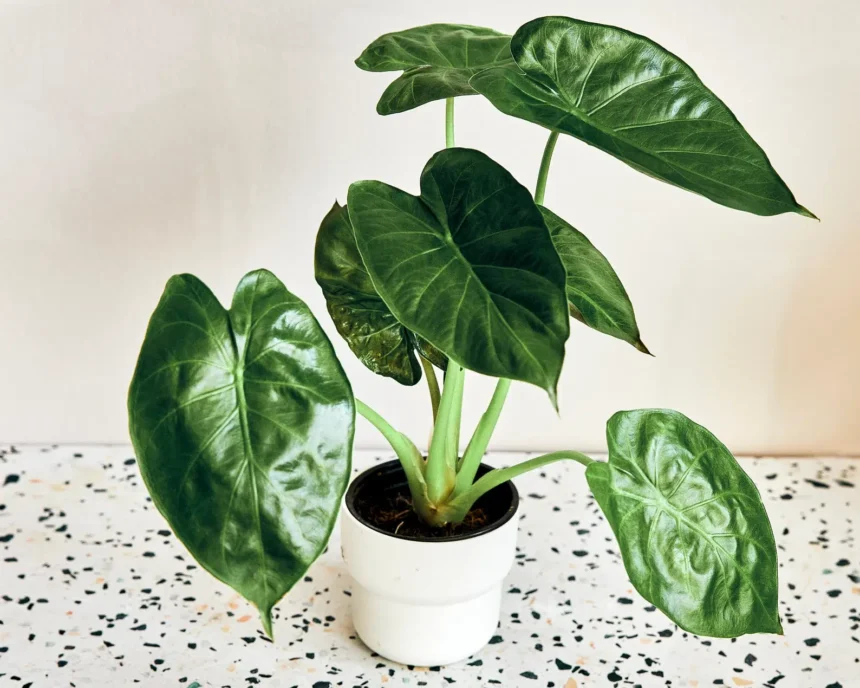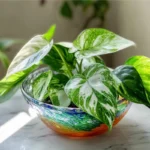Alocasia Wentii: The Foolproof Guide to Growing This Stunning Houseplant
Alocasia Wentii, also known as Hardy Elephant Ear or New Guinea Shield, is a hybrid tropical plant celebrated for its bold, arrow-shaped leaves and ease of care. This gorgeous houseplant thrives with the right balance of humidity, light, and moisture—making it accessible for beginners and rewarding for seasoned plant enthusiasts alike.
Let‘s dive into everything you need to know to grow and care for Alocasia Wentii, from creating the ideal conditions to propagating and troubleshooting common problems.
Quick Overview of Alocasia Wentii
Here’s a snapshot of the key details you’ll need to understand this plant’s care requirements:
- Common Names: Hardy Elephant Ear, New Guinea Shield
- Botanical Name: Alocasia wentii
- Plant Type: Herbaceous, Perennial
- Mature Size: Up to 5 ft indoors; up to 10 ft outdoors
- Light Requirements: Bright, indirect light
- Soil Needs: Well-drained, fertile, and moist
- USDA Hardiness Zones: 8–10
- Toxicity: Toxic to humans and pets
Why Alocasia Wentii is So Easy to Grow
Alocasia Wentii may appear quite the diva, but if it has the right environment, then anyone can easily grow this show-stopping plant. Here‘s what it thrives on.
1. Light Requirements
To keep your Alocasia Wentii looking its best, place it in bright, indirect light. Too much direct sun will scorch its beautiful leaves, while too much shade may lead to leggy growth or dormancy.
- Best Placement Indoors: Near a north or east-facing window. If light is too intense, sheer curtains can diffuse sunlight effectively.
- Outdoors: Grow outside under partial shade, such as a tree canopy or sheltered patio.
- Grow Tip: Provide supplemental grow lights if the light at home is minimal.
2. The Perfect Soil Mix
This plant thrives in well-draining, fertile soil. To create the ideal potting mix:
- Combine 1 part perlite, 1 part coco coir, and 1 part houseplant potting soil for proper drainage and moisture retention.
- For sustainable alternatives, you can also use LECA (Lightweight Expanded Clay Aggregate) as a potting medium.
3. Watering: Keep It Balanced
Consistency is key when watering Alocasia Wentii. Keep the soil evenly moist without letting it become soggy or completely dry.
- Check the top 1–2 inches of soil: If dry, it’s time to water.
- Overwatering can cause root rot, while underwatering may result in wilting and leaf drop.
Pro Tip: Use your fingers to test moisture levels twice a week.
4. Temperature and Humidity
Alocasia Wentii grows best in daytime temperatures of 68°F–77°F. What sets this plant apart is its ability to tolerate lower temperatures of 45°F, though its foliage won’t look as lush.
For humidity, aim for levels between 60–70%:
- Boost Humidity Indoors: Use a humidifier, group plants together, or place the pot on a pebble tray filled with water.
- If you grow Alocasia outdoors in USDA zones 8–10, it will thrive in warm, humid climates.
5. Fertilizing for Glossy Growth
Alocasia Wentii is a heavy feeder during its growing season (spring to summer). Fertilize every 2–3 weeks with a balanced liquid houseplant fertilizer to encourage vibrant, glossy leaves.
- Skip Fertilizer During Dormancy: Pause feeding in winter and resume when new growth appears.
Pruning Alocasia Wentii: Keep It Tidy
Pruning is simple: remove any yellowing, dead, or unhealthy leaves as they appear. This will redirect the plant’s energy toward healthy new growth.
How to Propagate Alocasia Wentii
Alocasia Wentii cannot be propagated from stem cuttings, but you can easily propagate new plants through division or corm offsets:
1. Propagation by Division
Here’s how to divide the rhizomes from a mature plant:
- Wait until spring when the plant exits dormancy.
- Keep soil moist beforehand to make removing the plant easier.
- Carefully remove the plant and shake off excess soil.
- Use sterile scissors to divide a clump of rhizomes from the central stem.
- Replant the rhizomes in well-draining soil and place them in bright, indirect light.
2. Propagation from Offshoots (Corms)
You may notice bulb-like corms in your plant’s pot. These are offsets that can grow into new plants:
- Gently remove the corms during spring.
- If the corm has roots, plant it in a new pot.
- For corms without roots, peel off the brown husk, place them in water (submerged ¾ of the way), and cover with plastic wrap to maintain high humidity.
Once roots form, transfer the corm to soil and keep it evenly moist.
Common Problems with Alocasia Wentii and How to Fix Them
1. Yellow Leaves
Cause: Overwatering, underwatering, or too much direct sunlight.
- Solution: Adjust watering and relocate to bright, indirect light.
2. Leaf Drop
Cause: Dormancy in winter, inconsistent watering, or low humidity.
- Solution: Maintain even moisture and high humidity.
3. Brown Leaf Edges
Cause: Dry air, overexposure to sunlight, or pests.
- Solution: Boost humidity, move the plant to indirect light, and check for spider mites or mealybugs.
FAQ About Alocasia Wentii
1. How tall can Alocasia Wentii grow?
Indoors, it can reach 5 feet, while outdoors, it grows up to 10 feet in ideal conditions.
2. Is Alocasia Wentii toxic to pets?
Yes, this plant is toxic to both pets and humans due to its calcium oxalate crystals. Keep it out of reach from curious pets.
3. Is Alocasia Wentii rare?
Yes, it’s one of the rarer Alocasia varieties and may require sourcing from specialty nurseries.
Final Thoughts
Alocasia Wentii is a striking plant that’s surprisingly beginner-friendly with the right care. Its glossy, oversized leaves make it a statement piece in any space. With proper lighting, watering, and humidity, you’ll be able to grow this tropical beauty with ease—and maybe even encourage its rare blooms!







